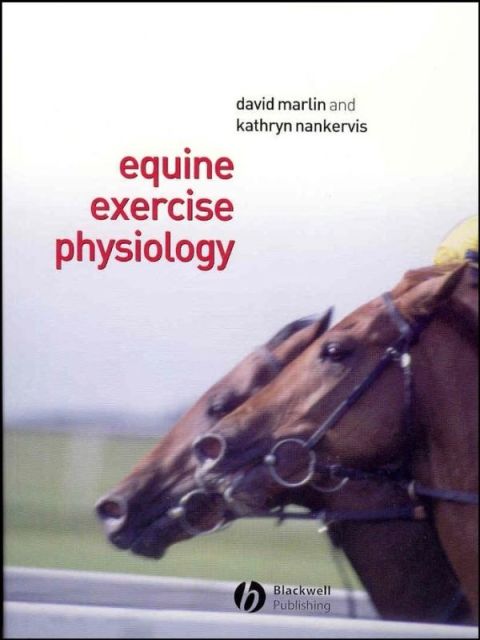Description
Efnisyfirlit
- Cover
- Contents
- Title Page
- Copyright
- Foreword
- Acknowledgements
- Part I: The Raw Materials
- 1 Introduction
- Why train?
- What are the aims of a training programme?
- Exercise, work, training, fitness and performance
- 2 Energetics of exercise
- Introduction
- The resting horse
- The energy for muscle contraction
- The conversion of food into useful energy for exercise
- Energy pathways
- Energy partitioning
- Size of the fuel stores
- Running out of energy
- 3 Muscles
- Introducing skeletal muscle
- Inside the muscle cell
- How does the nerve impulse make the muscle contract?
- Properties of muscular activity
- Muscle fibre types and distribution
- Type I fibres (red endurance muscle)
- Type II fibres (white sprint muscle)
- Muscle capillary supply
- Muscle fibre recruitment
- Distribution of muscle fibre types
- 4 Connective tissue
- Tendons and ligaments
- Bones
- 5 The respiratory system
- Respiration, breathing, ventilation
- Anatomy of the respiratory system
- How much air goes in and out?
- What makes the air go in and out of the lung?
- Pleural membranes
- Ventilation–perfusion matching and mismatching
- How easy is it to inflate the lungs?
- Getting gases across the alveolar–capillary membrane
- 6 The cardiovascular system
- Types of blood vessel
- The heart as a pump
- Cardiac output
- Electrical conduction through the heart
- The cardiac cycle
- The electrocardiogram (ECG)
- Control of blood flow
- Control of blood pressure
- The composition of blood
- Red blood cells (erythrocytes)
- Haematology and clinical biochemistry
- Part II: Exercise and Training Responses
- 7 Muscular responses
- The muscular response to exercise
- The muscular response to training
- How long does it all take?
- How long does it all last?
- 8 Skeletal responses
- Mechanical properties of bone
- The influence of exercise on modelling and remodelling
- The responses of bone to training
- Training bone in practical terms
- Responses of cartilage to training
- Responses of tendons to training
- 9 Respiratory responses
- The oxygen pathway
- Ventilation
- Respiratory–locomotory coupling
- Alveolar ventilation
- Is respiratory–locomotory coupling over-rated?
- Pulmonary resistance
- The struggle to breathe
- The work of breathing
- Exercise-induced arterial hypoxaemia
- Respiratory response to training
- 10 Cardiovascular responses
- The heart in exercise and performance
- Maximal oxygen uptake
- Splenic reserves
- Blood pressure during exercise
- Matching oxygen demand and supply
- The cardiovascular response to training
- 11 Aspects of physiological stress and fatigue
- Stress
- 12 Thermoregulation
- Replacing fluid losses
- Replacing electrolyte losses
- Assessing environmental thermal stress
- Acclimatisation and acclimation
- Management of competitions in thermally stressful environments
- Thermoregulation in the cold
- 13 Introduction to biomechanics
- Studying the gaits
- Kinetics and force plates
- Studying kinematics
- Stride length and stride frequency
- The gaits
- Gallop
- Gait transitions
- The rider
- Energy cost
- The jump stride
- Spinal kinematics and back problems
- Bow and string theory
- Part III: Applications of Exercise Physiology
- 14 The demands of equestrian sport
- Eventing
- Endurance
- Racing
- Showjumping
- Polo
- 15 Training principles
- Horses are natural athletes
- Training objectives
- Training specificity
- Identify the challenge
- Training intensity, frequency, duration and volume
- Tapering for peak performance
- Overtraining
- Detraining
- 16 Training facilities
- Training and racing surfaces
- Hoof–surface interaction
- Treadmills
- Swimming pools
- Water treadmills
- 17 Practical training
- How fit does the horse need to be?
- How long will it take?
- Can you bring all the systems to a peak at once?
- How do I construct a training programme?
- How should interval training be carried out?
- Learning to ride at a set speed
- How hard should the horse work and how soon should I increase the intensity?
- Load carried
- Ideal body condition
- How long can you keep a horse at a peak?
- What do you do if the horse has an enforced lay-off?
- Keeping athletes on the road
- 18 Exercise testing
- Why would you want to use an exercise test?
- Standardisation and specificity
- Examples of field exercise tests
- Fitting a heart rate monitor
- Simple field tests using a heart rate monitor
- Treadmill testing
- Comparison of overland versus treadmill exercise
- Types of treadmill test
- What can you measure on a horse exercising on a treadmill?
- 19 Indicators of performance
- What is performance testing?
- Which is best – field tests or treadmill tests?
- The effect of training on indicators of performance
- Biomechanical indicators of performance
- Poor performance and loss of performance investigation
- 20 Feeding performance horses
- What do we want from a feed ration?
- Water – the most important ingredient
- Water and electrolytes
- Meeting total daily energy requirements
- Quick release and slow release of energy
- Monitoring body mass and condition
- Minerals for performance horses
- Herbal supplements
- Miscellaneous supplements
- Drugs and performance
- 21 Transport
- What happens to a horse during transport?
- Weight loss during transport
- Recovery following transport
- Recommendations for preparation, transport and acclimatisation for the 1996 Atlanta Olympic Games
- References
- Further Reading
- Index







Reviews
There are no reviews yet.